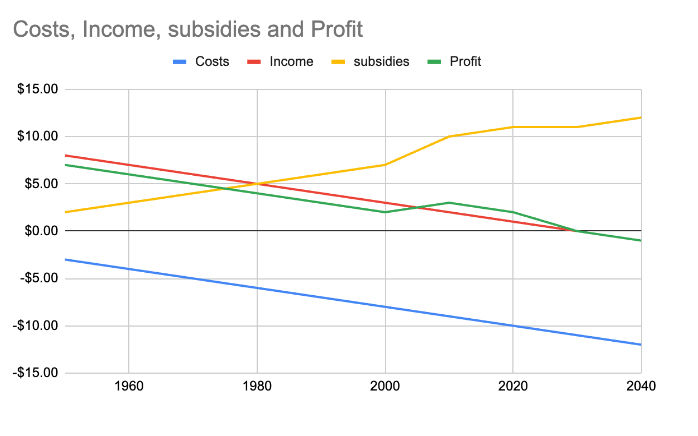Farmland Crisis Summary
- Cinque Mason
- Jun 15, 2024
- 3 min read
I started off with saying-I believe farmland is overvalued so much that farmers will be unable to make their payments and there will be a collapse. Also due to degradation of soil quality from petrochemicals farm productivity is falling and will be unable to keep up with current market and bank loan demands. What do you think?
Alan (https://understandingag.com/partners/allen-williams/) responded- I Absolutely agree, he then described to me a situation far worse than I thought.
The American farming landscape faces a looming crisis due to overvalued farmland and declining productivity. This situation, described by agricultural experts like Alan Williams, points to an unsustainable future.
Farmland appreciation rates outpace agricultural commodity prices. For instance, corn sells at $5 per bushel, yet the costs for row crop farming hover around $1000 per acre, with an average yield barely covering expenses, let alone land costs. Most farmers rely heavily on subsidies, with up to 70% of revenue coming from taxpayer programs. This dependence shifts focus from sustainable farming to 'farming the farm bill,' prioritizing financial gains over soil health. This is the same for Ranching as well.
Market demand influences production decisions minimally, with farmers sticking to traditional crops like corn and soybeans. Record-keeping practices vary widely, with little focus on surplus management or anticipating market fluctuations. The commodity timeline reflects a complex chain from farm to consumer, heavily influenced by speculative futures markets.
To address these challenges, a realistic financial estimate should consider actual production costs, including living expenses and true yield projections. Farming must move away from chemical additives and subsidies towards a sustainable, free-market approach. However, regulatory inconsistencies and climate concerns complicate this transition.
The correction needed involves a significant drop in land values, as current prices far exceed actual agricultural worth. Speculators stand to lose, and a reevaluation of farming practices is essential to avoid a future crisis, including environmental degradation, water scarcity, and food deficits. Encouraging young farmers and prioritizing soil health are critical steps towards a sustainable agricultural future.
A global famine is predicted to be in the next 10-20 years if it does not change
soil depletion comes from microorganisms being stimulated from artificial additives such as ammonium nitrate which causes the microorganisms to consume carbon within the soil at unprecedented rates that can be replenished in time. The soil naturally containing the carbon as well as sequestration from the plants the carbon is used as somewhat of structural support within the soil allowing water and nutrients to be moved efficiently. Additives such as ammonium nitrate cause ‘soil collapse’ a physical event where the soil crushes in on itself not allowing nutrients and water to move through the soil. The implications of this causes mass dying events within the soils ecosystem which to note there is 1 trillion microbial cells in a single gram of soil. Plants have evolved alongside soil and a healthy plant demands healthy soil. We can artificially create growth in the plant but at the expense of the plant that is not sustainable without an increased amount of additives year over year which is actually a form of depreciation for a variety of reasons.
When the soil infrastructure is destroyed during normal rain or mass rain events the water cannot be consumed and retained by the soil causing it to run off. When it runs off it takes the top soil with it which is the most area needed for crop production and ecosystem strength and livability. When the topsoil is washed away it ruins the crop for this season and the next season if not built back in time which likely it won't be able to be built back especially under conventional farming tactics it will only get worse.
When the soil strength is gone during these same mass raining events the water is not going in the earth and goes down flood ways and causes mass flooding. This is seen in areas of mass deforestation notably in the global south. Although artificial production increases short term production for minimal capital cost like what was seen in the 1950s it can't be sustained and it is not being accurately depicted in financial modeling
Farmers have been given a subsidiary lifeline and credit line that's backed by the US federal government that accounts for 45-70% of farm income. These subsidies are added in when doing the valuation of a farm. Most conventional farms are negative without subsidies. Only positive with the addition of subsidies. Yet, that's what the financial institutions deem is best fit for the valuation of farmland, a false number backed and inflated by the US government. The farmland value is also propped up from market speculation in Chicago, REITs desire to develop all of America, and the core belief that America's farmland and production could never crash.
Graphs are not based on real figures but rather depicting the causation effect from our actions and the implications that are not being spoken about.








Comments